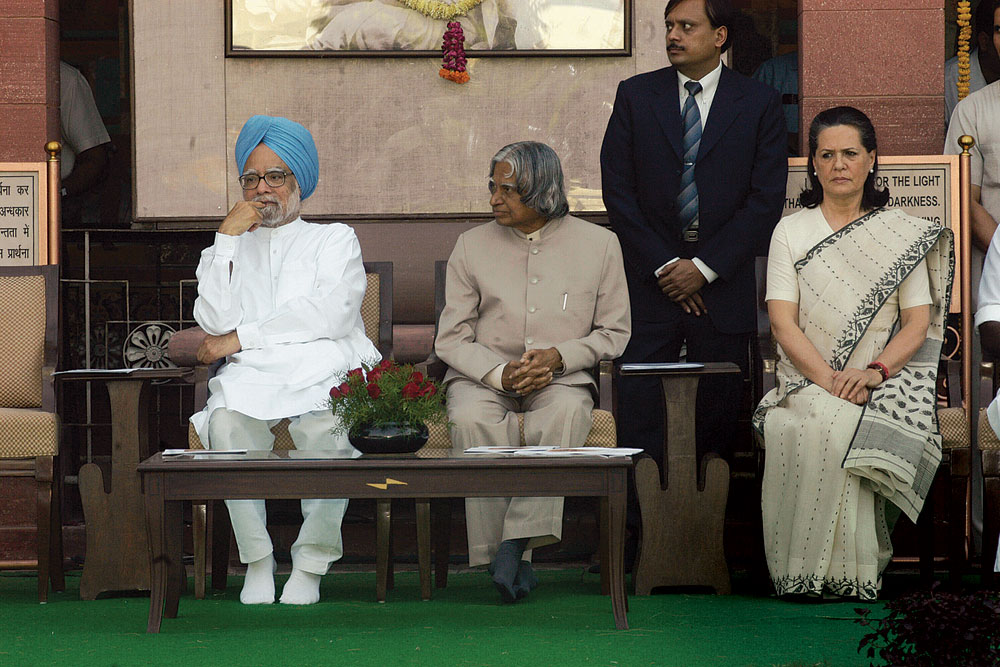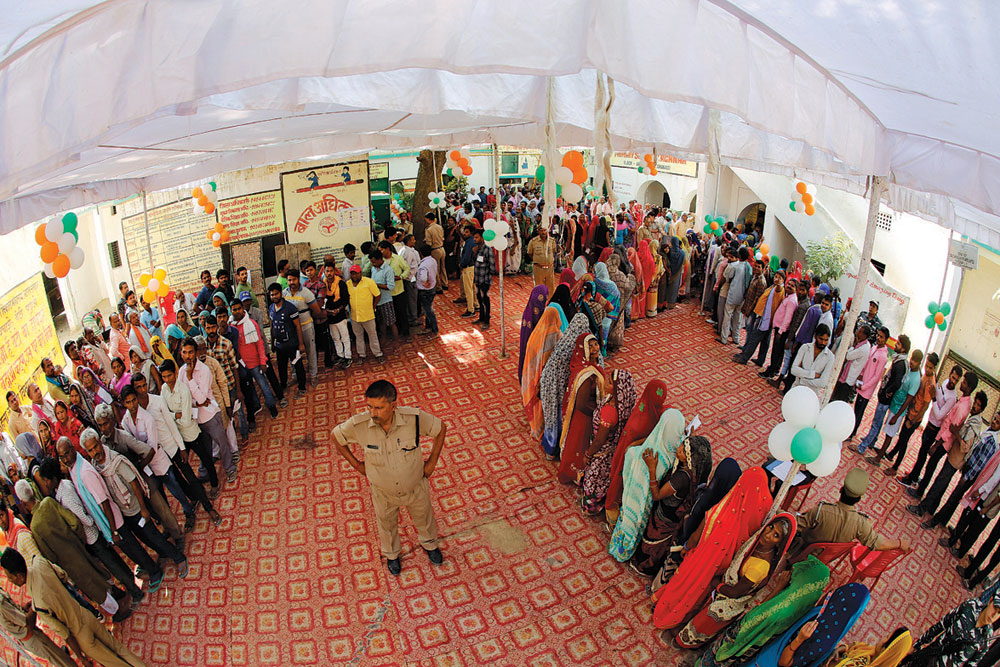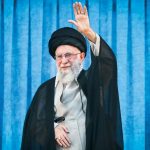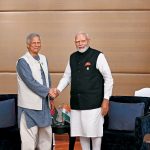In Praise of the Indian Voter
The redeeming surprises of a volatile democracy
 Shashi Tharoor
Shashi Tharoor
 Shashi Tharoor
Shashi Tharoor
 |
26 Jun, 2020
|
26 Jun, 2020
/wp-content/uploads/2020/06/Indianvoter1.jpg)
(Illustration: Saurabh Singh)
DEMOCRACY, WINSTON CHURCHILL famously wrote, is the worst system of government in the world, except for all the others. One of its defining characteristics is its unpredictability, since democracy reflects the wishes of large numbers of people expressed in the quiet intimacy of the polling booth. The wonders of democracy have repeatedly startled the world as the voters of India have confounded all the pundits and pollsters to place the country in the hands of different governments led by different parties or coalitions. India’s first Prime Minister, Jawaharlal Nehru, would have been proud of this. His greatest satisfaction would have come from the knowledge that the democracy he tried so hard to instil in India had taken such deep roots, despite so many naysayers claiming that democracy would never work in a developing country.
As a result, India has managed the process of political change and economic transformation necessary to develop our country and to forestall political and economic disaster. Much as it is tempting to do so, this cannot, in all good conscience, be accredited to some innate beneficence that one acquires along with the right to an Indian passport. Rather, I credit Indian democracy and civic nationalism, rooted in the constitutional rule of law and free elections.
Every Indian General Election is immediately the world’s largest exercise in democratic franchise—with some 900 million registered voters in 2019, that is hardly surprising. And look what happens in these elections: governments are routinely voted out of office, and voters hold politicians accountable for their development promises. And they do so within India’s extraordinary framework of diversity: for instance, as I have often pointed out with pride, in May 2004, India witnessed a General Election victory by a woman leader of Roman Catholic background and Italian heritage (Sonia Gandhi) making way for a Sikh (Manmohan Singh) to be sworn in as Prime Minister by a Muslim (President APJ Abdul Kalam)—in a country 80 per cent Hindu.
India’s democracy has flourished while pursuing some of the most intractable challenges of development the world has known. Of course, fiercely contentious politics remains a significant impediment to India’s development, since reforms are pursued with hesitancy as governments keep looking constantly over their electoral shoulders. But this also ensures the acceptance of reforms when they are eventually made.
India has also been proud of being able to demonstrate, in a world riven by ethnic conflict and notions of clashing civilisations, that democracy is not only compatible with diversity, but preserves and protects it. No other country in the world, after all, embraces the extraordinary mixture of ethnic groups, the profusion of mutually incomprehensible languages, the varieties of topography and climate, the diversity of religions and cultural practices, and the range of levels of economic development that India does. Yet Indian democracy, rooted in the constitutional rule of law and free elections, has managed the processes of political change and economic transformation necessary to develop our country. This is an experience that some who are currently in power appear to forget, or devalue.
As I have repeatedly argued in my writings, India is united not by a common ethnicity, language or religion, but by the experience of a common history within a shared geographical space, reified in a liberal constitution and the repeated exercise of democratic self-governance in a pluralist polity. India’s founders wrote a constitution for this dream; we in India have given passports to their ideals. So the idea of India is of one land embracing many. It is the idea that a nation may endure differences of caste, creed, colour, culture, conviction, cuisine, costume and custom, and still rally around a democratic consensus. That consensus is about the simple principle that in a democracy you do not really need to agree all the time—except on the ground rules of how you will disagree. The reason India has survived all the stresses and strains that have beset it for seven decades, and that led so many to predict its imminent disintegration, is that it maintained consensus on how to manage without consensus. That consensus now seems to be in question, as the Indian that was comfortable with the idea of multiple identities and multiple loyalties, all coming together in allegiance to a larger idea of India, is now being forced to yield to a narrower India privileging Hindi-speaking Hindus.
The Indian voter has long since resolved the ‘bread versus freedom’ debate so beloved of intellectuals: the question of whether democracy can literally ‘deliver the goods’ in a country of poverty and scarcity, or whether its inbuilt inefficiencies only impede rapid growth
The Indian voter has long since resolved the ‘bread versus freedom’ debate so beloved of intellectuals: the question of whether democracy can literally ‘deliver the goods’ in a country of poverty and scarcity, or whether its inbuilt inefficiencies only impede rapid growth. Some still ask—as they were prone to when three Governments fell between 1996 and 1998—if the instability of political contention (and of makeshift coalitions) is a luxury a developing country cannot afford, and whether, as today’s young concentrate on making their bread, they should consider political freedom a dispensable distraction. Some argue back that not only is democracy not incompatible with economic growth and progress, it is the only guarantee that growth and progress will be stable and self-sustaining. But they do so with diminishing conviction, in the face of the relentless assault of Moditva.
This is where lies the great battle for Indian nationhood, and for the survival and success of India’s civic nationalism. I used to aver that no one identity can ever triumph in India: both the country’s chronic pluralism and the logic of the electoral marketplace had made this impossible. In leading a coalition Government, and then in losing office, the first iteration of the Hindutva-inclined Bharatiya Janata Party (BJP) Government learnt that any party with aspirations to rule India must reach out to other groups, other interests, other minorities. After all, there are too many diversities in our land for any one version of reality to be imposed on all of us. The second iteration—the Modi Government—has twice been elected with an absolute majority, for reasons I have explained elsewhere, and does not need the support of others. Might it, then, emboldened by its current levels of support, remake India’s nationalism altogether? I have looked at this question from different angles and tried to provide a satisfactory response, but the battle is still being fought and it is impossible to predict exactly how the future might unfold.
Democracy is a process and not just an event; it is the product of the exchange of hopes and promises, commitments and compromises which underpin the sacred compact between governments and the governed. Democracy is also about how to lose, and that is something Indians have repeatedly learnt, as multiple changes of governments have confirmed. But democracy flourishes within a specific defined framework of nationhood, and that is where India is beset by the uncertain fear that the framework itself is being rattled.
Yet civic nationalism is vital for India’s future. While there is no easy way to cope with the country’s extraordinary diversity, democracy is the only technique that can work to ensure all sections of our variegated society the possibility of their place in the sun. Elections and civic institutions are the instrument for ensuring this. What is encouraging for the future of democracy is that India is unusual in its reach; in India, electoral democracy is not an elite preoccupation, but matters most strongly to ordinary people. Whereas in the US a majority of the poor do not vote—in Harlem in 10 presidential elections before 2008 (when a credible black candidate, Barack Obama, ran), the turnout was below 23 per cent—in India the poor exercise their franchise in great numbers. It is not the privileged or even the middle-class who spend four hours queueing in the hot sun to cast their vote, but the poor, because they know their votes make a difference
THE EXPERIMENT BEGUN seven decades ago by India’s founders has worked. Though there have been major threats to the nation from separatist movements, caste conflicts and regional rivalries, electoral democracy has helped defuse them. When violent movements arise, they are often defused through accommodation in the democratic process, so that in state after state, secessionism is defeated by absorption into civic nationalism. Separatism in places as far afield as Tamil Nadu in the south and Mizoram in the Northeast has been defused in one of the great unsung achievements of Indian democracy: Yesterday’s secessionists have, in many cases, become today’s chief ministers. (And thanks to the
vagaries of democratic politics, tomorrow’s opposition leaders.)
It’s still true that in many parts of India, when you cast your vote, you vote your caste. But that too has brought about profound alterations in the country, as the lower castes have taken advantage of the ballot to seize electoral power. The explosive potential of caste division has been channelled through the ballot box. Most strikingly, the power of electoral numbers has given high office to the lowest of India’s low. Who could have imagined, for 3,000 years, that a Dalit woman would rule as Chief Minister of India’s most populous state? Yet Mayawati has done that three times in Uttar Pradesh, on the basis of her electoral appeal. And even the ascent of a self-declared ‘chaiwala’ (tea-seller) to the position of Prime Minister is a testament to the triumph of Indian democracy.

On the 50th summer of India’s Independence, KR Narayanan, a Malayali Dalit—a man who was born in a thatched hut with no toilet and no running water, whose university refused to award him his degree at the same ceremony as his upper-caste classmates—was elected President of India. He led an India whose injustices and inequalities he had keenly felt as a member of an underprivileged community; yet an India that offered—through its brave if flawed experiment in constitutional democracy, secularism, affirmative governmental action and change through the ballot-box—the prospect of overcoming these injustices. Five years later, he was succeeded by a Tamil Muslim, a fisherman’s son who sold newspapers in the street as a boy and who happened to be the father of India’s missile program. Today, the highest office in the land is again occupied by a member of the Dalit community, Ram Nath Kovind, who rose to the top from humble beginnings in Uttar Pradesh . If the presidency symbolises the Indian state, it is still a symbol of India’s diversity and its egalitarian democracy.
The question of whether democracy and development can go together has also been answered convincingly by India. Some experts have argued that democracy does not lend itself to rapid development—that the compromises that are an essential element of democratic governance, and the need for decision-makers in a democratic society to take the wants of their constituents into account, were distractions that less developed states could ill afford if they were to make the hard decisions necessary to improve their futures.
In May 2004, India witnessed a general election victory by a woman leader of Roman Catholic background and Italian heritage making way for a Sikh to be sworn in as Prime Minister by a Muslim-in a country 80 per cent Hindu
In its first few decades after Independence from Britain in 1947, India was seen as the global posterchild for the virtues of democracy, in contrast to its giant neighbour, China, which turned into a communist dictatorship in 1949. Till the 1970s, it was widely argued that while both countries suffered the horrors of poverty, under-development and disease, India’s was the superior model because its people were free to choose their own rulers. As China surged ahead economically from 1978 onwards, however, the debate changed: it was now argued that China’s was clearly the superior economic performance, while India’s chaotic democracy held its people back from the efficient pursuit of prosperity.
This was apparent across the board, notably in infrastructure development. If China wanted to build a new six-lane expressway, it could bulldoze its way past any number of villages in its path; in India, if you wanted to widen a two-lane road, you could be tied up in court for a dozen years over compensation entitlements. But the flip side of India’s weakness is its strength: India has mechanisms to deal with dissent, whereas China’s suppression of politics could prove unsustainable in the long run, when a more educated populace began to assert its rights.
The old debate has now taken a new twist with the publication by Daniel A Bell, an American professor at Beijing’s Tsinghua University, of the book The China Model: Political Meritocracy and the Limits of Democracy, which argues that the authoritarianism intrinsic to China’s success is actually a viable model of governance which might in fact be superior to India’s (and the West’s) democracy. Bell cites the remarkable economic success of an assortment of non-democracies in recent years. Certainly, countries like Singapore and China have prospered in recent decades through benign authoritarianism, built on what Bell calls ‘political meritocracy’. While Amartya Sen famously demonstrated that famines don’t occur in democracies with a free press because their governments would be unable to ignore the suffering, Bell argues that China has also avoided famine and done better than democratic India on malnutrition. In other words, you don’t have to be democratic to serve your people effectively. That is an argument that could well appeal to some in the current Indian political leadership.
Bell focuses on the methods for choosing political leaders in both systems of government and suggests that the authoritarian selection processes, based strictly on merit, guarantees better leadership than the random enshrining of ignorance and prejudice in democratic voting. China’s economic success can be attributed, he says, to the way it selects, evaluates and promotes officials. Despite some weaknesses (notably complacency and corruption), it ensures orderly governance and development, which democracy doesn’t necessarily do. The ‘politically relevant question,’ he says, ‘is whether democratic elections lead to good consequences.’
It’s a question India debated once before, exactly 40 years ago, when then Prime Minister Indira Gandhi declared a state of Emergency in 1975, suspended India’s civil liberties, locked up the opposition leadership and censored the press. She argued explicitly then that democracy in India had detracted from development. The issue became known as the ‘bread versus freedom’ debate: the question of whether democracy can literally deliver the goods in a country of poverty and scarcity, or whether its inbuilt inefficiencies only impede the prospects of rapid growth.
That debate was resolved in India by the elections of 1977, which defenestrated the Emergency regime and restored democracy. But the question has not gone away, and the dysfunctional politics of democratic India in recent years has made it seem even more relevant. When, for a quarter of a century, India was ruled by governments in Delhi made up of over 20 political parties, political decision-making was determined by the lowest common denominator: the weakest link in the governmental chain determined its strength. Is that an efficient way of ensuring the well-being of the Indian people? Arguably not. But is the over-centralised, top-down, unitary autocracy being engineered by the Modi Government any better?
I am not persuaded that Bell’s affirmative answer (for the Chinese version of totalising nationalism) is the right one. While rapid industrialisation and development has pulled millions of Chinese out of poverty, it has often come at great cost in human suffering. China may have grown at breakneck speed—but it has broken necks in the process.
WHATEVER ONE MIGHT say about India’s sclerotic bureaucracy versus China’s efficient one, India’s tangles of red tape versus China’s unfurled red carpet to foreign investors, India’s contentious and fractious political parties versus China’s smoothly functioning, top-down communist hierarchy, there’s no doubt that India had become an outstanding example of the management of diversity through pluralist democracy. Every Indian had been allowed to feel he or she has as much of a stake in the country, and as much of a chance to run it, as anyone else.

The legitimacy of democracy in India comes from the faith of the vast numbers of underprivileged rather than the minuscule elite. It is the poor who turn out in large numbers to vote, because the poor know that their votes matter. They also believe that exerting their franchise is the most effective means of demonstrating what they really demand from the government.
Frustration with Indian governments manifests itself in voting against the rulers rather than in revolts or insurrections. The Chinese system wasn’t designed to cope with fundamental challenges to it except through repression. But every autocratic state in history has come to a point where repression was no longer enough. If that point is reached in China, all bets are off. The dragon could stumble where the elephant can always trundle on.
One of the problems of the Chinese system is that it is too bureaucratic. It only permits gradual and graduated ascent up the ladder, making it impossible for a young and relatively inexperienced but exciting leader like Barack Obama to emerge.
It would fail to pick gifted leaders who were failures in their youth, like FD Roosevelt, Abraham Lincoln or for that matter MK Gandhi or Jawaharlal Nehru. Rebels and non-conformists who have flourished in Indian politics would never have got to first base in the Chinese system.
Democracy is a process and not just an event; it is the product of the exchange of hopes and promises, commitments and compromises which underpin the sacred compact between governments and the governed
The Chinese model denies its citizens a say in the kinds of policies the nation should pursue and eliminates any possibility of mediating among competing value systems, ideologies and political and economic choices. Politics is about more than efficient management—it is also about representing different segments of society and accommodating their views and interests. This only liberal democracy within a framework of civic nationalism can do Bell cites the successes of authoritarian systems but does not acknowledge that these successes do not require authoritarianism. The methods employed by China and the other East Asian ‘tigers’ to promote economic growth and development, which include economic competition, use of international markets, spread of education and land reforms, have in fact been consistent with democratic principles. As a result, many formerly authoritarian states in East Asia have become democracies at no cost to their development success stories. And no people who have gained democratic rights have clamoured for a return to the blessings of dictatorship, a clinching refutation of the Bell view.
Indian democracy is a strength, not a weakness. The Chinese system requires consensus and cooperation from top to bottom. It will flounder, and founder, if that consensus ever breaks down. This is why the Chinese model works in a predictable environment, but the Indian model may be better to cope with the perils of an uncertain world. And just as we are aware—and proud—of modern India’s strong democratic traditions, we are also aware of our responsibility to develop—to seek to bring all our people into the 21st century with comfortably full bellies and comfortably fulfilling occupations. Democracy and human rights are fundamental to who we are; but human rights begin with breakfast.
So modern India has struggled to come to terms with what has sometimes been seen as the competing demands of freedom and development, just as it has struggled with the need to fully respect diversity and at the same time strengthen and pay homage to our sense of identity. Democracy, as precept and practice, will never wear the mantle of perfection. I have written in my books of the many problems that India faces, the poor quality of much of its political leadership, the rampant corruption, the criminalisation of politics. And yet—corruption is being tackled by an activist judiciary and by energetic investigative agencies that have not hesitated to indict the most powerful Indian politicians. (If only the rate of convictions matched the rate of indictments, it would be even better… .) The rule of law remains a vital Indian strength.
The liberal institutions of our civic nationalism give every member of our polity an opportunity to pursue their constitutional rights.The Congress-led United Progressive Alliance Government (2004-2014) ensured the rearming of India’s rights regime (with the Right to Information Act, the Mahatma Gandhi National Rural Employment Guarantee Act, the Right to Education Act and other liberal entitlements such as to food security and welfare), along with near-double-digit economic growth, a dramatic drop in the number of Indians living below the poverty line and even a nuclear deal with the US. It is that entire edifice of acquired rights for Indians that is under threat from today’s hyper-nationalist assault, in addition to the Nehruvian idea of India and the civic nationalism that informed these rights-based policies.
The challenge in Indian nationalism has always been that of finding ways of acknowledging and accommodating difference. To my mind, this entails one thing: to reaffirm, and to fight for, India’s endangered civic nationalism, in the face of the determined effort to replace it with an ethno-religious nationalism as India’s ruling credo. This must involve a reassertion of our democracy and a defiant deepening of the habits of democratic practice in our political culture, which is in currently the process of wrenching the Indian people away from democracy in the name of identitarian majoritarianism.
The India of tomorrow will only flourish if it resists the undermining of these strengths by a rampant Hindu nationalism, strengthens its civic institutions and shores up its liberal democracy. That is the challenge that awaits India in the 21st century.

/wp-content/uploads/2025/07/Cover_Dalai-Lama.jpg)












More Columns
Gukesh’s Win Over Carlsen Has the Fandom Spinning V Shoba
Mothers and Monsters Kaveree Bamzai
Nimrat Returns to Spyland Kaveree Bamzai